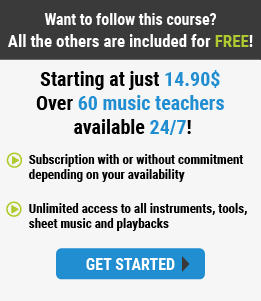Beginner Piano Lessons – Welcome to the world of Piano
291 videos
Learn the piano with the specialist Erik Deutsch! Discover a full progressive method for piano beginners. Get all the main notions and techniques to begin!
Beginner Piano Lessons – Welcome to the world of Piano
Take beginner piano lessons with a jazz pianist . This course offers a general basic understanding of harmony, rhythm, chords, scales, and note reading. You will practice and improve your piano techniques with the help of many rhythmic exercises, ear training and backing tracks with which you can play along.
We have selected various popular songs in the course; these will not only build your repertoire but help you improve your musical skills. The include “Hey Jude”, “Love is All”, “Somewhere Over the Rainbow”, and “Sing”.
Upon completion of this course, our goal is for you to be able to play popular music on the piano, accompany yourself while you sing, or even play in a band.
LESSON PRESENTATION
The main concepts taught
Music Theory
Rhythm
Chords
Perfect Fifth
Major and minor third
Fingering
Inversion Triads
Octaves
Double Staff reading
The program proposed by Erik Deutsch
Take full beginner piano lessons with Erik Deutsch and imusic school!
he method proposed by Erik aims to teach all the fundamental basics of piano. The content of these piano beginner lessons is adapted to novices and concepts are introduced step by step.
This course is divided into 13 chapters and counts more than 291 videos. You will learn the following notions and techniques: hand positions, fingering, rhythm, chords, scales, intervals, triads, and note reading.
| Chapter | Detailed Notions |
Get to Know your Piano |
Erik starts his course by telling your more about the instrument structure, the position of your body, hands and fingers. You will also learn some basic but essential music theory. |
Rhythm is Love |
This second session focuses on the rhythm. You will understand what is a whole note, a half note, a quarter note and a time signature. Erik will also show you how to use a metronome. |
The root of a Chord |
Erik Deutsch explains you what is a chord, and what is a triad. You’ll do ear exercises to recognize if a chord is minor or major. You will also learn to read a chord chart. Exercises are available at the end of each new notion or technique. |
The perfect Fifth |
In this chapter, discover what is the perfect fifth, and practice the perfect fifth on the left and right hand thanks to exercises. Then, learn the root-5th alternating, meaning moving up the scales alternating between the root and the fifth. After that, disover how to use the sustain pedal! Practice all you have seen in this chapter in a series of exercises about easy songs to play. |
The Major Third |
In this part, Erik gives you the definition of the major third, a very important interval in piano. He proposes you some exercises to practice the major third with separate hands, and hands together, ascending and descending. You are also given fingering tips for the major third practice. |
The minor Third |
After having discovered the major third, you will see more in details the minor third. Similarly to the previous chapter, you will practice this notion thanks to a series of exercises. |
Repertoire |
In this repertoire session, remember all you have learned so far and play on the famous songs “Hey Jude” and “Sing”. |
The Major Triad |
Here, learn what is a major triad, a main notion in piano. Practice the major triad on easy songs versions. |
The minor Triad |
Similarly to the previous chapter, discover what is a minor triad. Then, practice this notion, and mix both major and minor triads in a piece. After that, discover the enharmonic spellings. You will learn to use black keys to build triads. |
1st inversion Triads |
In this chapter, you will learn a brand new notion: the first inversion triad, very useful to pass from a chord to another. Practice the 1st inversion triad thanks to a series of exercises. |
2nd inversion Triads |
Here is the follow-up of the previous chapter. You learn how to do a second inversion based on the first inversion, to change chords. |
The Octave |
Discover what are octaves. Erik shows you how to play them on the piano on white and black keys, and with right and left hands. After that, you’re invited to play octaves on chromatic scales. Train on “Love is All”, “Aura Lee”, “Hey Jude” and “Somewhere Over the Rainbow”, and play whole chords with both hands! Then, Erik explains what is a rest in music, and suggests you to practice with the help of rhythm exercises. Now see what is double staff reading with Erik. |
Congratulations |
Be proud of your musical path and receive the congratulations from your teacher Erik Deutsch for this first step into the world of piano! |
A word from your teacher
"This program is great, we've put a lot of time into it, we have given all of time and energy to make it this course the best as we can. And we think we are going to have a lot of fun, and most importantly you're going to learn to play the piano with a great method!"





